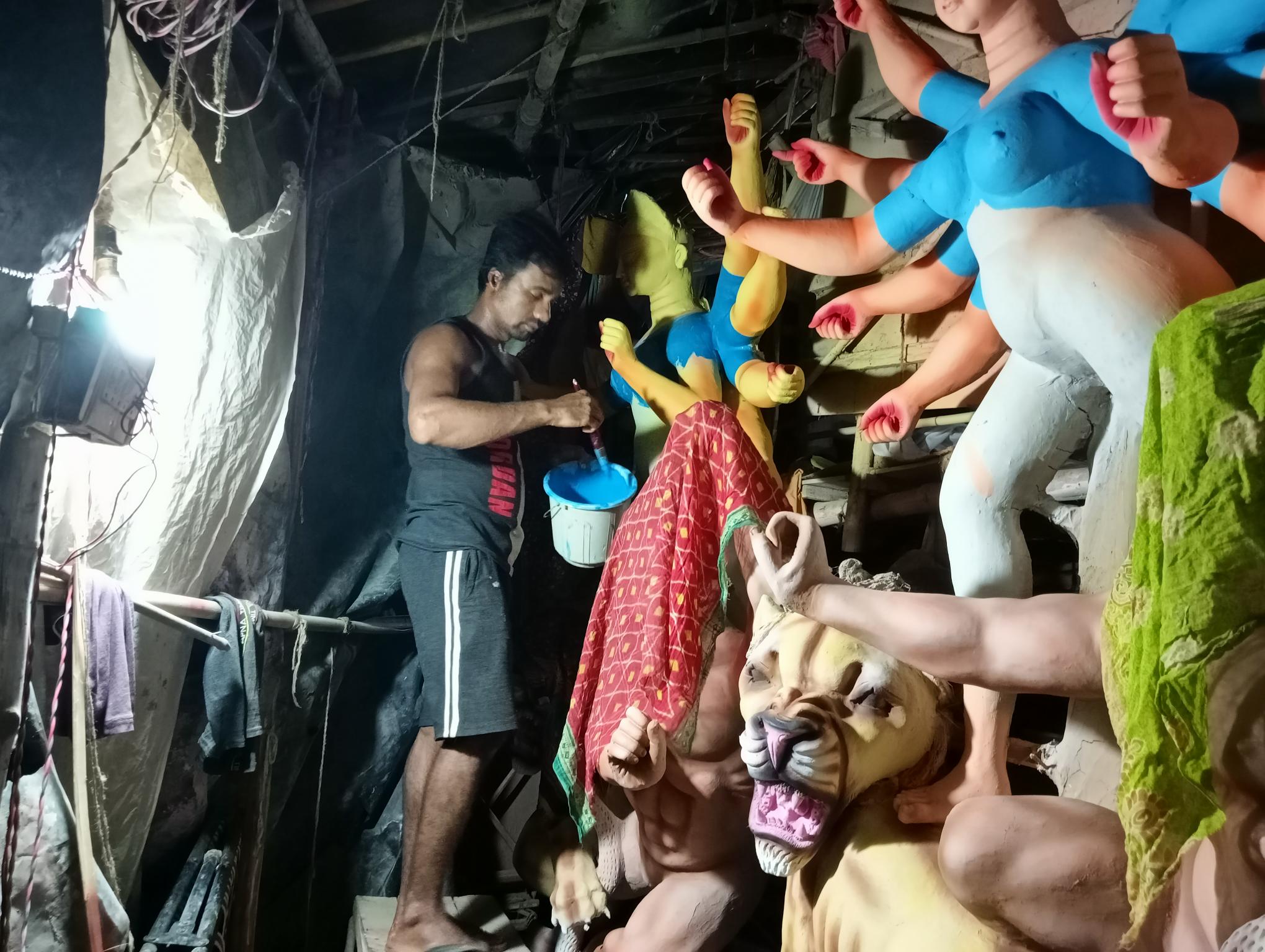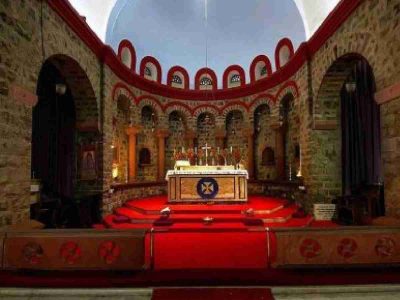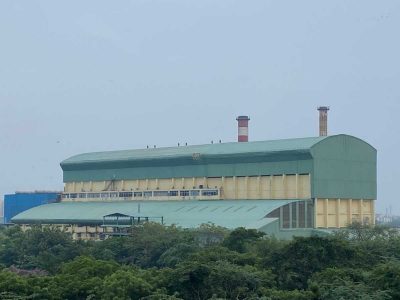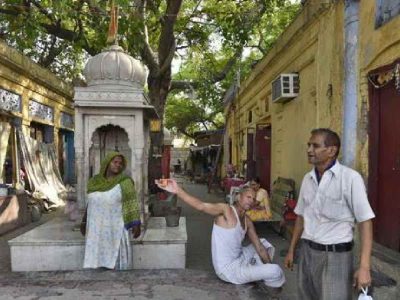“A farmer brings food to your table, but goes to bed hungry. Similarly, artists bring shine to festivals, but do not earn name or price,” says Sanjiv Mondal, while his fingers flawlessly carve out a floral design from a white paper that would be used as decoration in the CR Park Kali Mandir Durga Puja pandal.
In the heart of festivities, where colours dance and lights gleam, a silent symphony plays in a labourer’s dream.
Every year, Sanjiv along with hundreds like him, are the unsung architects of joy who travel thousands of miles away from West Bengal to infuse life in every crease of the Goddess and decorate her abode.
Hidden from limelight
As autumn paints the town in hues of festivity, the idol and pandal makers labour in obscurity.
“We arrive here a month before the festivities begin. It takes nearly 30 days and we leave on Saptami (the second day of Durga Puja). However, we are still better off. Those who are in charge of the building of the pandals cannot leave until they dismantle it after Lakshmi Puja (four-five days after Dashami, the day of immersion of the Goddess). The idol makers are the last ones to leave! While most leave after Lakshmi Puja, a good number of them stay back until the end of Kali Puja (during Diwali),” he says.
Somnath Pal, an idol maker from Nadia district, came to Delhi in June this year and will leave only after Diwali.
“Biporjosto lage, kintu kaaj thame na. Jokhon Bangalir utshober shomoy, tokhon amader chokhe ghum, shorire glani (We feel wrecked, but our work goes on. When the whole city celebrates around us, our eyes are in slumber and our bodies ache from exhaustion).”
In the quiet alleys where clay meets imagination, skilled hands mould deities with deep dedication.
The 35-year-old has not celebrated Durga Puja or Kali Puja with his family in 12 years, since he began working outside Bengal.
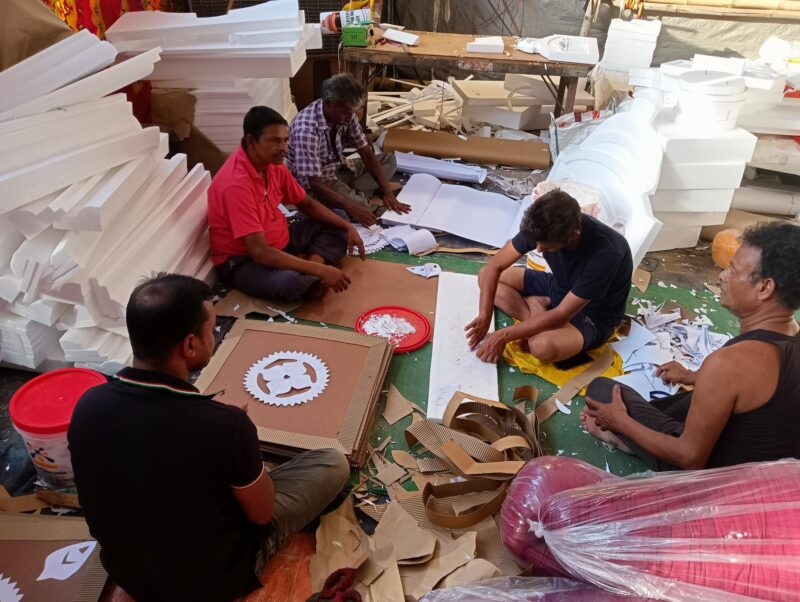
“Most of us artisans start travelling outside around June and return around November last week. Rest of the year we are there in Bengal doing other work. My family members are all artisans involved in some form of art,” he adds.
A sizeable population of the Pal community, have historically been into the art of pottery. These days, Somnath and his team of 15 idol makers are working round the clock, their hands weaving magic.
“We start at eight in the morning and work till 4am. We forgo sleep during the last 20 days of the making of the Goddess. The drawing of the eye is the hardest. Around afternoon, our bodies sometimes begin to shiver out of exhaustion, so we sleep a little. From 3pm-5pm, we try to rest a little,” he says.
“Since a lot of us are outside during the two primary Bengali Hindu festivals, we make it up during Rash (a popular festival in Nadia).”
Murtis (idols or sculptures) of Vishnu, Shiva, Goddess Durga, Goddess Kali, Krishna, Radha, Annapurna, Jagadhatri and Shirdi Sai Baba are made during Rash and worshipped in public pandals and homes. They are then paraded on the streets.
“We feel seen there,” he says.
Despite the hardships, Somnath says that he does not want to do anything else because “this is our life now. I love what I do and feel like the blessings of the Goddess is always with me because it is me who brings her to life”.
Keepers of tradition
The centuries-old Bengali traditions gently unfold in the hands of these sculptors. Behind these alleys of Goddesses, in the shadows of their humble abode, striped lungis are hanging neatly, telling a story of identity and neglect.
Somnath has also worked in Kumartuli, a traditional potters’ quarter in northern Kolkata renowned for its sculpting prowess and export of idols.
But Doyal Das has worked as an idol maker only outside Bengal.
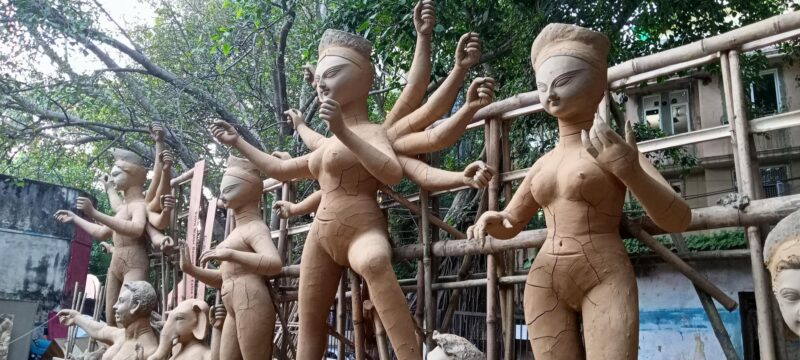
Less than a kilometre from Kali Mandir, Doyal is miffed at a crowd of photographers collecting images of his work, leaving him “bereft of sleep in the afternoon”.
“Please do not touch the idols and increase our work. No, you cannot take visuals for free,” he can be heard roaring.
“People come here to take photographs and videos for free. How can you expect this? Even in Kumartuli, people have to pay some amount to witness the art. So, why not us,” he says, as his co-worker Samanto, who has previously worked in Kumartuli, agrees.
“Is this how you respect an artist’s work?”
Doyal travels to Delhi every year because “there is far less competition in this work outside Bengal. So, it is easier to get work even though the wage is not much.”
The idol makers are usually associated with a contractor, from whom they receive a salary every month during this period.
“Some of us live in Delhi now. We do other kinds of work here,” says Samanto, who lives in Chhatarpur.
“There is no respect for artisans here. We have not particularly faced any misbehaviour, that is true, but nobody even cares about us. They just want their orders to be delivered on time. No one even gives a piece of cloth to us out of respect,” says Doyal, who hails from West Medinipur.
Talking about what is in demand, Doyal says that when it comes to idol, it is only the traditional Debi murti that people order in Delhi.
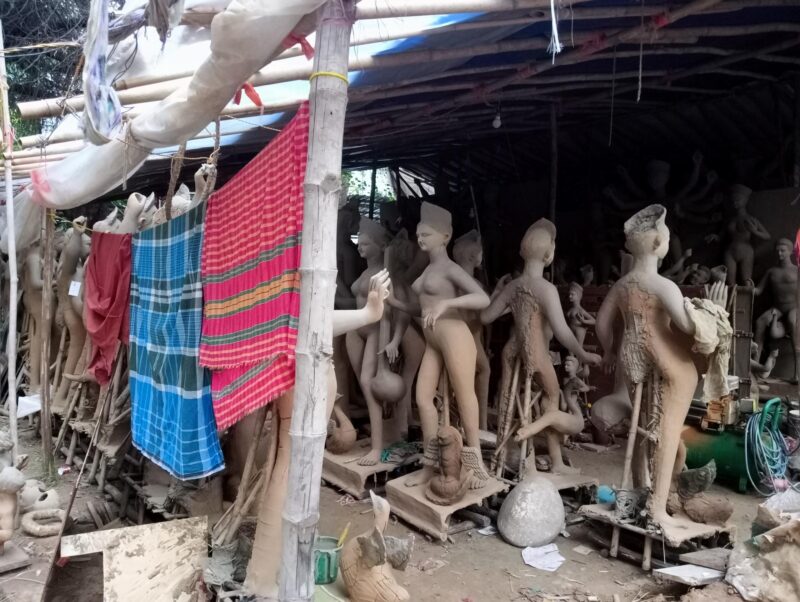
“We give our own touch and make it colourful. The clothes are sometimes painted or are made typically of silk or cotton. The most extravagant ones are that of daaker shaaj).”
During the Zamindari era, a century ago, the raw materials (thermocol, metallic wires, sheets and foils) were imported from other countries, mainly Germany.
Since the import took place by post (known as daak in Bangla), this special type of ornamentation became popular by the name of Daaker Shaaj.
Meanwhile, back in the premises of Kali Mandir, Sanjiv has found friends in his team.
“We live like a family here. Every year we travel to different cities and make friends with those we work in a team. Most of us who work in pandal decoration are from Diamond Harbour (in South 24 Parganas district). When we return home, we make it a point to visit each other during Kali Puja,” says the 41-year-old.
Just that afternoon, it was Dinu Mondal’s turn to cook fish and Sanjiv was in charge of making rice.
“We met each other here and we already have plans for Kali Puja together. During Deepawali, even if you pay us Rs 5,000 extra, we will not leave our homes. We stay put here and wait for Kali Puja to arrive. For us, that is the main festival,” Sanjiv says.
Talking about the returns or recognition, Sanjiv says that only when their pandal wins a prize they get a trophy or a memento.
“But the prize money goes to the Committee and we get no share. The hard work is ours. Money is always for the Babus. However, something is better than nothing,” he says, chuckling.
Jagat Mallah climbs the dizzying heights to bind colourful cloth to the bamboo, building the deity’s shrine.
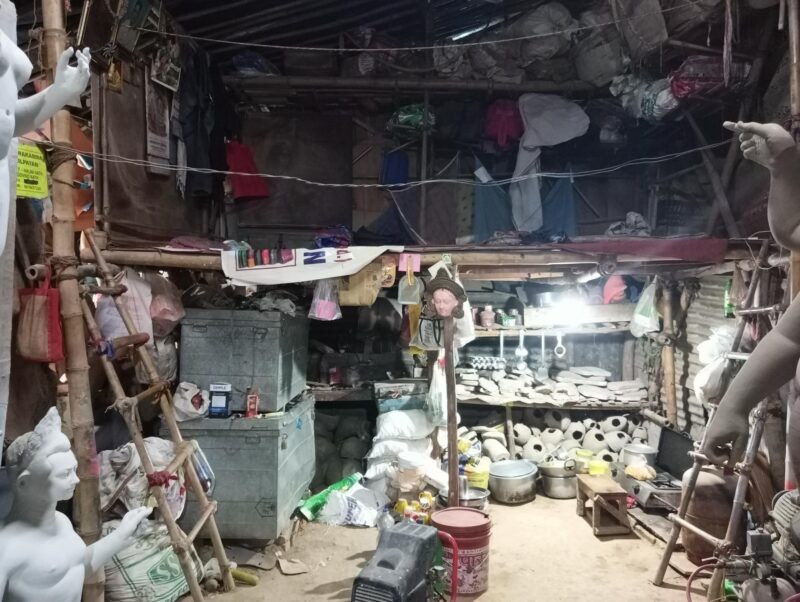
“We fell from the height so many times that now we do not even think about risking life and limb. Falling has become part and parcel of our job. But yes, with experience you develop better balance. For example, I cannot remember falling and fracturing a limb in recent past. But he did,” he says, pointing towards Ranjan, while giggling and turning it into a banter.
When Ranjan fell from the top last year at the RK Puram Durga Puja pandal, it was the committee members who rushed him to the nearby hospital for treatment. However, the cost of the treatment was his own.
Enchanters
At several big parks, joy is wafting through the air as pandals are coming up and children are watching closely in awe. In these pandals and bustling corners, festival enchanters have also arrived.
Suchitra Mondal came to Delhi at the age of 19 soon after her marriage with Kanu. She began helping her husband in his local Kolkata-style snack stall in Govindpuri.
“In 1991, we decided to put a stall in the nearby Durga Puja pandals and show our culinary prowess. We have always put up a stall since then. Till 2018, we used to jump from one pandal to another, but now we are always here at the B Block pandal,” says Suchitra.
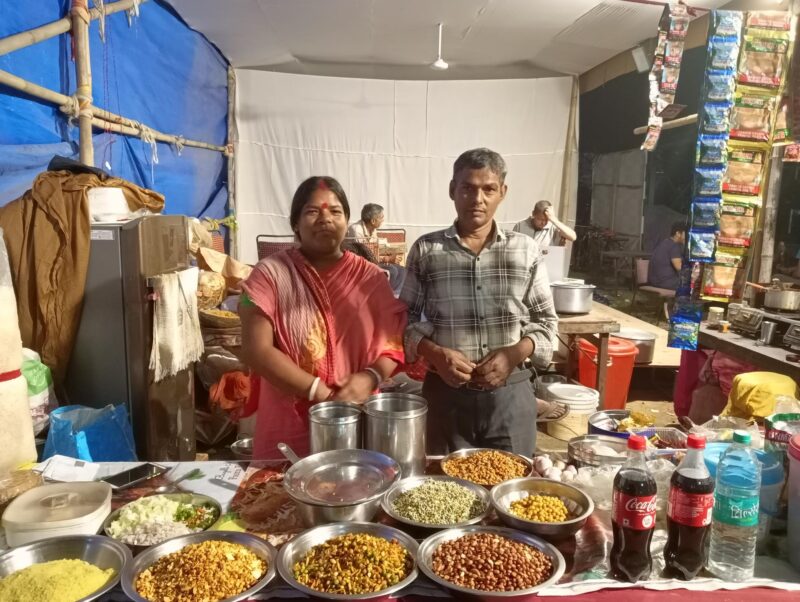
At Suchitra and Kanu’s stall, there is an assortment of vegetarian and non-vegetarian snacks, but her mutton ghugni — the traditional chana daal made in mutton stock and pieces — “steals the show”.
There is a beeline around her stall with the young and old loudly calling for the nth cup of tea and muri as they decide on the menu of Anandamela (a feast and fun fair inside the pandals to ring in the festival a day before it begins).
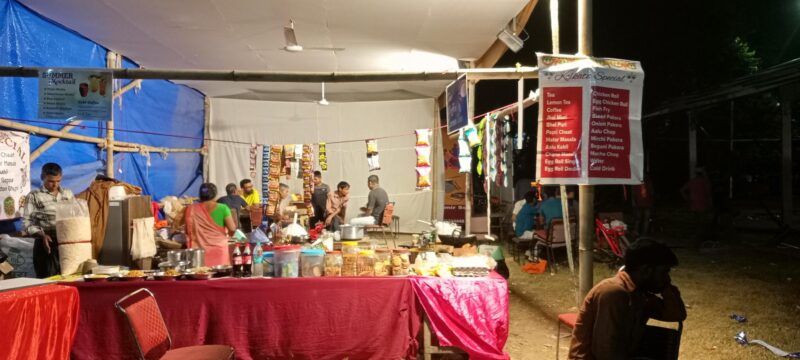
“We love it here. Especially the fact that we are at the centre of so much joy. When people come here and tell us that they loved our food, the hard work feels worth it,” says Kanu.
While the feeling is “thrilling”, the couple is unable to make much profit in business as raw materials for the food are expensive and the return is not as much.
“The profit has been cut by half in the last four years. It started deteriorating in 2019 and since then it is not at all moving in a positive direction,” he rues.
However, the couple feels that every year as Durga Puja arrives, a better flow of money also arrives with the Goddess, “despite the many hardships that follow”.

